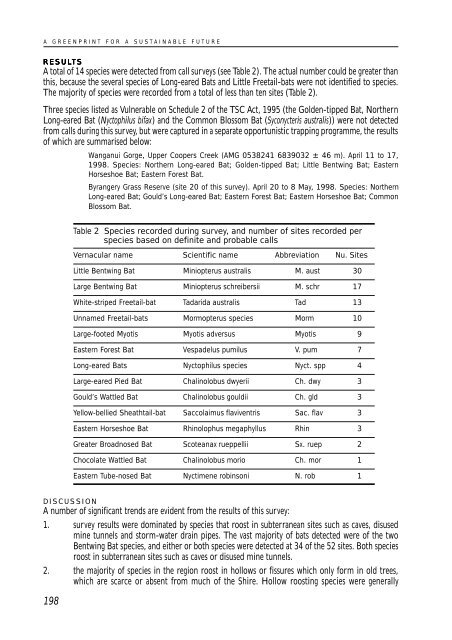Byron Flora and Fauna Study 1999 - Byron Shire Council
Byron Flora and Fauna Study 1999 - Byron Shire Council
Byron Flora and Fauna Study 1999 - Byron Shire Council
You also want an ePaper? Increase the reach of your titles
YUMPU automatically turns print PDFs into web optimized ePapers that Google loves.
A GREENPRINT FOR A SUSTAINABLE FUTURE<br />
RESULTS<br />
A total of 14 species were detected from call surveys (see Table 2). The actual number could be greater than<br />
this, because the several species of Long-eared Bats <strong>and</strong> Little Freetail-bats were not identified to species.<br />
The majority of species were recorded from a total of less than ten sites (Table 2).<br />
Three species listed as Vulnerable on Schedule 2 of the TSC Act, 1995 (the Golden-tipped Bat, Northern<br />
Long-eared Bat (Nyctophilus bifax) <strong>and</strong> the Common Blossom Bat (Syconycteris australis)) were not detected<br />
from calls during this survey, but were captured in a separate opportunistic trapping programme, the results<br />
of which are summarised below:<br />
Wanganui Gorge, Upper Coopers Creek (AMG 0538241 6839032 ± 46 m). April 11 to 17,<br />
1998. Species: Northern Long-eared Bat; Golden-tipped Bat; Little Bentwing Bat; Eastern<br />
Horseshoe Bat; Eastern Forest Bat.<br />
Byrangery Grass Reserve (site 20 of this survey). April 20 to 8 May, 1998. Species: Northern<br />
Long-eared Bat; Gould’s Long-eared Bat; Eastern Forest Bat; Eastern Horseshoe Bat; Common<br />
Blossom Bat.<br />
Table 2 Species recorded during survey, <strong>and</strong> number of sites recorded per<br />
species based on definite <strong>and</strong> probable calls<br />
Vernacular name Scientific name Abbreviation Nu. Sites<br />
Little Bentwing Bat Miniopterus australis M. aust 30<br />
Large Bentwing Bat Miniopterus schreibersii M. schr 17<br />
White-striped Freetail-bat Tadarida australis Tad 13<br />
Unnamed Freetail-bats Mormopterus species Morm 10<br />
Large-footed Myotis Myotis adversus Myotis 9<br />
Eastern Forest Bat Vespadelus pumilus V. pum 7<br />
Long-eared Bats Nyctophilus species Nyct. spp 4<br />
Large-eared Pied Bat Chalinolobus dwyerii Ch. dwy 3<br />
Gould’s Wattled Bat Chalinolobus gouldii Ch. gld 3<br />
Yellow-bellied Sheathtail-bat Saccolaimus flaviventris Sac. flav 3<br />
Eastern Horseshoe Bat Rhinolophus megaphyllus Rhin 3<br />
Greater Broadnosed Bat Scoteanax rueppellii Sx. ruep 2<br />
Chocolate Wattled Bat Chalinolobus morio Ch. mor 1<br />
Eastern Tube-nosed Bat Nyctimene robinsoni N. rob 1<br />
DISCUSSION<br />
A number of significant trends are evident from the results of this survey:<br />
1. survey results were dominated by species that roost in subterranean sites such as caves, disused<br />
mine tunnels <strong>and</strong> storm-water drain pipes. The vast majority of bats detected were of the two<br />
Bentwing Bat species, <strong>and</strong> either or both species were detected at 34 of the 52 sites. Both species<br />
roost in subterranean sites such as caves or disused mine tunnels.<br />
2. the majority of species in the region roost in hollows or fissures which only form in old trees,<br />
which are scarce or absent from much of the <strong>Shire</strong>. Hollow roosting species were generally<br />
198

















